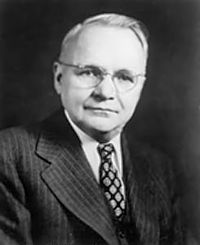- Harry Nyquist
-
Harry Nyquist 
Harry Nyquist (1889-1976)Born February 7, 1889
Stora Kil, Nilsby, Värmland, SwedenDied April 4, 1976 (aged 87)
Harlingen, Texas, USAResidence USA Citizenship American Fields Electronic engineer Institutions Bell Laboratories Alma mater Yale University
University of North DakotaDoctoral advisor Henry Andrews Bumstead Known for Nyquist–Shannon sampling theorem
Nyquist rate
Johnson–Nyquist noise
Nyquist stability criterion
Nyquist ISI criterion
Nyquist plot
Nyquist frequency
Nyquist filter
Fluctuation dissipation theoremNotable awards IEEE Medal of Honor
Stuart Ballantine Medal (1960)Harry Nyquist (né Harry Theodor Nyqvist; English pronunciation: /ˈnaɪkwɪst/, Swedish: [nʏːkvɪst]; February 7, 1889 – April 4, 1976) was an important contributor to information theory.
Contents
Personal life
Nyquist was born in the Stora Kil parish of Nilsby, Värmland, Sweden. He was the son of Lars Jonsson Nyqvist (b. 1847) and Katrina Eriksdotter (b. 1857). His parents had seven children: Elin Teresia, Astrid, Selma, Harry Theodor, Aemelie, Olga Maria, and Axel. He emigrated to the USA in 1907.
Education
He entered the University of North Dakota in 1912 and received the B.S. and M.S. degrees in electrical engineering in 1914 and 1915, respectively. He received a Ph.D. in physics at Yale University in 1917.
Career
He worked at AT&T's Department of Development and Research from 1917 to 1934, and continued when it became Bell Telephone Laboratories in that year, until his retirement in 1954.
Nyquist received the IRE Medal of Honor in 1960 for "fundamental contributions to a quantitative understanding of thermal noise, data transmission and negative feedback." In October 1960 he was awarded the Stuart Ballantine Medal of the Franklin Institute "for his theoretical analyses and practical inventions in the field of communications systems during the past forty years including, particularly, his original work in the theories of telegraph transmission, thermal noise in electric conductors, and in the history of feedback systems." In 1969 he was awarded the National Academy of Engineering's fourth Founder's Medal "in recognition of his many fundamental contributions to engineering."
Nyquist lived in Pharr, Texas after his retirement, and died in Harlingen, Texas on April 4, 1976.
Technical contributions
As an engineer at Bell Laboratories, Nyquist did important work on thermal noise ("Johnson–Nyquist noise"),[1] the stability of feedback amplifiers, telegraphy, facsimile, television, and other important communications problems. With Herbert E. Ives, he helped to develop AT&T's first facsimile machines that were made public in 1924. In 1932, he published a classical paper on stability of feedback amplifiers.[2] The Nyquist stability criterion can now be found in all textbooks on feedback control theory.
His early theoretical work on determining the bandwidth requirements for transmitting information laid the foundations for later advances by Claude Shannon, which led to the development of information theory. In particular, Nyquist determined that the number of independent pulses that could be put through a telegraph channel per unit time is limited to twice the bandwidth of the channel, and published his results in the papers Certain factors affecting telegraph speed (1924)[3] and Certain topics in Telegraph Transmission Theory (1928).[4] This rule is essentially a dual of what is now known as the Nyquist–Shannon sampling theorem.
See also
References
- ^ H. Nyquist, "Thermal Agitation of Electric Charge in Conductors", Phys. Rev., Vol. 32, pp. 110-113, 1928
- ^ H. Nyquist, "Regeneration theory", Bell System Technical Journal, vol. 11, pp. 126-147, 1932
- ^ Nyquist, Harry. "Certain factors affecting telegraph speed". Bell System Technical Journal, 3, 324–346, 1924
- ^ Nyquist, Harry. "Certain topics in telegraph transmission theory", Trans. AIEE, vol. 47, pp. 617–644, Apr. 1928 Reprint as classic paper in: Proc. IEEE, Vol. 90, No. 2, Feb 2002.
External links
- IEEE Global History Network page about Nyquist
- Nyquist criterion page with photo of Nyquist with John R. Pierce and Rudy Kompfner
- K.J.Astrom: Nyquist and his seminal papers, 2005 presentation
- Nyquist biography, p. 2
IEEE Medal of Honor 1951–1975 Vladimir Zworykin (1951) · Walter R. G. Baker (1952) · John M. Miller (1953) · William L. Everitt (1954) · Harald T. Friis (1955) · John V. L. Hogan (1956) · Julius Adams Stratton (1957) · Albert Hull (1958) · Emory Leon Chaffee (1959) · Harry Nyquist (1960) · Ernst A. Guillemin (1961) · Edward Victor Appleton (1962) · George C. Southworth (1963) · Harold A. Wheeler (1964) · Claude Elwood Shannon (1966) · Charles H. Townes (1967) · Gordon K. Teal (1968) · Edward Ginzton (1969) · Dennis Gabor (1970) · John Bardeen (1971) · Jay W. Forester (1972) · Rudolf Kompfner (1973) · Rudolf Kalman (1974) · John Robinson Pierce (1975)
Categories:- 1889 births
- 1976 deaths
- People from Kil Municipality
- American engineers
- American electrical engineers
- AT&T
- Control theorists
- IEEE Medal of Honor recipients
- Information theorists
- Information theory
- Scientists at Bell Labs
- American people of Swedish descent
- University of North Dakota alumni
- Yale University alumni
- Swedish emigrants to the United States
- Swedish information theorists
- Swedish engineers
Wikimedia Foundation. 2010.
